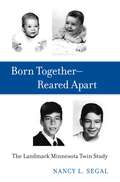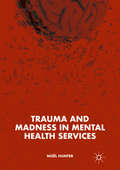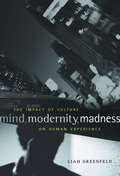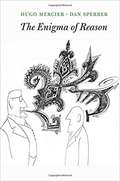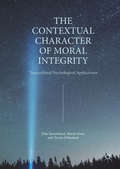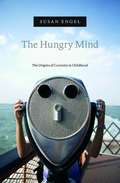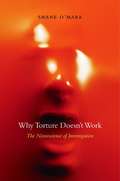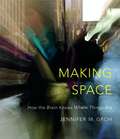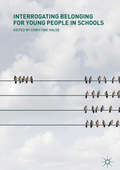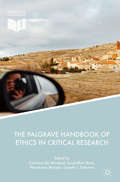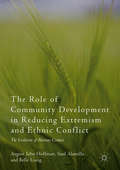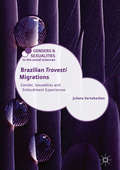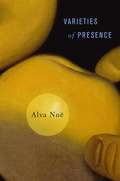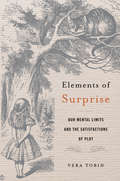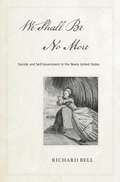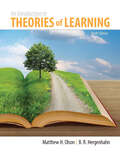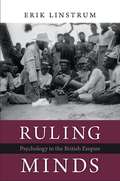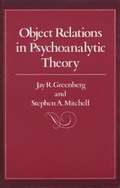- Table View
- List View
Born Together—Reared Apart: The Landmark Minnesota Twin Study
by Nancy L. SegalThe Minnesota Study of Twins Reared Apart startled scientists by demonstrating that twins reared apart are as alike, across a number of personality traits and other measures, as those raised together, suggesting that genetic influence is pervasive. Segal offers an overview of the study’s scientific contributions and effect on public consciousness.
Trauma and Madness in Mental Health Services (PDF)
by Noël HunterHow do survivors of child abuse, bullying, chronic oppression and discrimination, and other developmental traumas adapt to such unimaginable situations? It is taken for granted that experiences such as hearing voices, altered states of consciousness, dissociative states, lack of trust, and intense emotions are inherently problematic. But what does the evidence actually show? And how much do we still need to learn?
Mind, Modernity, Madness: The Impact Of Culture On Human Experience
by Liah GreenfeldA leading interpreter of modernity argues that our culture of limitless self-fulfillment is making millions mentally ill. Training her analytic eye on manic depression and schizophrenia, Liah Greenfeld, in the culminating volume of her trilogy on nationalism, traces these dysfunctions to society’s overburdening demands for self-realization.
The Enigma of Reason: A New Theory Of Human Understanding
by Hugo MercierIf reason is so useful and reliable, why didn’t it evolve in other animals and why do humans produce so much thoroughly reasoned nonsense? Hugo Mercier and Dan Sperber argue that reason is not geared to solitary use. It evolved to help justify our beliefs to others, evaluate their arguments, and better exploit our uniquely rich social environment.
The Contextual Character of Moral Integrity (PDF)
by Dita Šamánková Marek Preiss Tereza PříhodováThis book discusses outcomes of a study by the National Institute of Mental Health, Czech Republic, examining moral integrity in the post-communist Czech-speaking environment. Chapters map the history of the Euro-Atlantic ethical disciplines from moral philosophy and psychology to evolutionary neuroscience and socio-biology. The authors emphasize the biological and social conditionality of ethics and call for greater differentiation of both research and applied psychological standards in today’s globalised world. Using a non-European ethical system – Theravada Buddhism – as a case study, the authors explore the differences in English and Czech interpretations of the religion. They analyse cognitive styles and language as central variables in formatting and interpreting moral values, with important consequences for cultural transferability of psychological instruments. This book will appeal to academics and other specialists in psychology, psychiatry, sociology and related fields, as well as to readers interested in the psychology of ethics.
The Contextual Character of Moral Integrity: Transcultural Psychological Applications
by Dita Šamánková Marek Preiss Tereza PříhodováThis book discusses outcomes of a study by the National Institute of Mental Health, Czech Republic, examining moral integrity in the post-communist Czech-speaking environment. Chapters map the history of the Euro-Atlantic ethical disciplines from moral philosophy and psychology to evolutionary neuroscience and socio-biology. The authors emphasize the biological and social conditionality of ethics and call for greater differentiation of both research and applied psychological standards in today’s globalised world. Using a non-European ethical system – Theravada Buddhism – as a case study, the authors explore the differences in English and Czech interpretations of the religion. They analyse cognitive styles and language as central variables in formatting and interpreting moral values, with important consequences for cultural transferability of psychological instruments. This book will appeal to academics and other specialists in psychology, psychiatry, sociology and related fields, as well as to readers interested in the psychology of ethics.
The Hungry Mind: The Origins of Curiosity in Childhood
by Susan EngelDespite American education’s recent mania for standardized tests, testing misses what really matters about learning: the desire to learn in the first place. Curiosity is vital, but it remains a surprisingly understudied characteristic. The Hungry Mind is a deeply researched, highly readable exploration of what curiosity is, how it can be measured, how it develops in childhood, and how it can be fostered in school. “Engel draws on the latest social science research and incidents from her own life to understand why curiosity is nearly universal in babies, pervasive in early childhood, and less evident in school…Engel’s most important finding is that most classroom environments discourage curiosity…In an era that prizes quantifiable results, a pedagogy that privileges curiosity is not likely to be a priority.” —Glenn C. Altschuler, Psychology Today “Susan Engel’s The Hungry Mind, a book which engages in depth with how our interest and desire to explore the world evolves, makes a valuable contribution not only to the body of academic literature on the developmental and educational psychology of children, but also to our knowledge on why and how we learn.” —Inez von Weitershausen, LSE Review of Books
Why Torture Doesn't Work: The Neuroscience of Interrogation
by Shane O'MaraBesides being cruel and inhumane, torture does not work the way torturers assume it does. As Shane O’Mara’s account of the neuroscience of suffering reveals, extreme stress creates profound problems for memory, mood, and thinking, and sufferers predictably produce information that is deeply unreliable, or even counterproductive and dangerous.
Making Space: How the Brain Knows Where Things Are
by Jennifer M. GrohKnowing where things are seems effortless. Yet our brains devote tremendous power to figuring out simple details about spatial relationships. Jennifer Groh traces this mental detective work to show how the brain creates our sense of location, and makes the case that the brain’s systems for thinking about space may be the systems of thought itself.
Interrogating Belonging for Young People in Schools (PDF)
by Christine HalseIn an era when many young people feel marginalized and excluded, this is the first comprehensive, critical account to shed new light on the trouble of ‘belonging’ and how young people in schools understand, enact and experience ‘belonging’ (and non-belonging). It traverses diverse dimensions of identity, including gender and sexuality; race, class, nation and citizenship; and place and space. Each section includes a provocative discussion by an eminent and international youth scholar of youth, and is essential reading for anyone involved with young people and schools. This book is a crucial resource and reference for sociology of education courses at all levels as well as courses in student inclusion, equity and student well-being.
Interrogating Belonging for Young People in Schools
by Christine HalseIn an era when many young people feel marginalized and excluded, this is the first comprehensive, critical account to shed new light on the trouble of ‘belonging’ and how young people in schools understand, enact and experience ‘belonging’ (and non-belonging). It traverses diverse dimensions of identity, including gender and sexuality; race, class, nation and citizenship; and place and space. Each section includes a provocative discussion by an eminent and international youth scholar of youth, and is essential reading for anyone involved with young people and schools. This book is a crucial resource and reference for sociology of education courses at all levels as well as courses in student inclusion, equity and student well-being.
The Palgrave Handbook of Ethics in Critical Research
by Catriona Ida Macleod Jacqueline Marx Phindezwa Mnyaka Gareth J. TreharneThis handbook highlights the growing tensions surrounding the current dominant ethical clearance model which is increasingly being questioned, particularly in critical research. It draws on stories from the field in critical research conducted in a range of contexts and countries and on an array of topics. The authors involved in this collection encountered dilemmas, contradictions and surprises that brought about a change in their understanding of ethics. Throughout the book they discuss how ethics is an ongoing and situated struggle that requires researchers, at times, to traverse traditional ethical imperatives. Four sections lead readers through the complexities of grounded ethical practice: encountering systems, including Ethics Committees and institutions; blurring boundaries within research; the politics of voice, anonymity and confidentiality; and power relations in researching ‘down’, ‘up’, and ‘alongside’. This handbook is a resource for social science researchers using critical methodologies across a range of disciplines, as well as for students and teachers of ethics, in navigating the quandaries of ‘doing good’ while doing good research.
The Palgrave Handbook of Ethics in Critical Research
by Catriona Ida Macleod Jacqueline Marx Phindezwa Mnyaka Gareth J. TreharneThis handbook highlights the growing tensions surrounding the current dominant ethical clearance model which is increasingly being questioned, particularly in critical research. It draws on stories from the field in critical research conducted in a range of contexts and countries and on an array of topics. The authors involved in this collection encountered dilemmas, contradictions and surprises that brought about a change in their understanding of ethics. Throughout the book they discuss how ethics is an ongoing and situated struggle that requires researchers, at times, to traverse traditional ethical imperatives. Four sections lead readers through the complexities of grounded ethical practice: encountering systems, including Ethics Committees and institutions; blurring boundaries within research; the politics of voice, anonymity and confidentiality; and power relations in researching ‘down’, ‘up’, and ‘alongside’. This handbook is a resource for social science researchers using critical methodologies across a range of disciplines, as well as for students and teachers of ethics, in navigating the quandaries of ‘doing good’ while doing good research.
The Role of Community Development in Reducing Extremism and Ethnic Conflict: The Evolution of Human Contact
by August John Hoffman Saul Alamilla Belle LiangThe purpose of this text is to provide the reader with a comprehensive understanding of the nature of violence, aggression, extremism, and ethnic hate crimes in the US, and to explicate how community development, stewardship, and service may be implemented to address and reduce these problems. When individuals of diverse backgrounds are provided with engagement, interaction, and community-building stewardship programs, negative ethnic stereotypes are debunked, conflict is reduced, and individuals are more likely to communicate and build a more resilient and empowered community. Recent political and administrative policies have created a very tense environment among cities within the US, especially within communities that have larger populations of immigrant refugees and persons of varied ethnicities. This book aims to ameliorate some of that tension.
The Role of Community Development in Reducing Extremism and Ethnic Conflict: The Evolution of Human Contact
by August John Hoffman Saul Alamilla Belle LiangThe purpose of this text is to provide the reader with a comprehensive understanding of the nature of violence, aggression, extremism, and ethnic hate crimes in the US, and to explicate how community development, stewardship, and service may be implemented to address and reduce these problems. When individuals of diverse backgrounds are provided with engagement, interaction, and community-building stewardship programs, negative ethnic stereotypes are debunked, conflict is reduced, and individuals are more likely to communicate and build a more resilient and empowered community. Recent political and administrative policies have created a very tense environment among cities within the US, especially within communities that have larger populations of immigrant refugees and persons of varied ethnicities. This book aims to ameliorate some of that tension.
Brazilian 'Travesti' Migrations: Gender, Sexualities and Embodiment Experiences (Genders and Sexualities in the Social Sciences)
by Julieta VartabedianThis book sheds new light on the interconnections between identity, gender and geographical displacement. At its centre are Brazilian travesti migrants, assigned as male at birth but later seeking to convey the aesthetic attributes of women by repeatedly performing a minutely-studied type of femininity. Despite the fact that they have been migrating between Brazil and Europe for more than forty years, very little is know about them, especially in the English-speaking world. This work therefore fills a significant lacuna in our understandings of sexualities, bodies and trans issues, whilst rejecting hegemonic terms such as 'transsexual' and 'transgender' in favour of the specificity of the travesti. What it presents is an ethnographical study of their bodily and geographic-spatial migrations, analysing how they become travestis through the gendered modification of their bodies, their involvement in sex work, and the transnational migrations to Europe that many of them make. Examining their lives in both Brazil and Europe, it also analyses how their migrations influence the construction of their subjectivities. Drawing on extensive fieldwork in Brazil and Barcelona, this exciting book will appeal to all those interested in gender, sexuality and transgender issues.
Varieties of Presence
by Alva Noë Alva NoëThe world shows up for us, but, as Alva Noë contends in his latest exploration of the problem of consciousness, it doesn’t show up for free. We must show up, too, and bring along what knowledge and skills we’ve cultivated. As with a painting in a gallery, the world has no meaning—no presence to be experienced—apart from our able engagement with it.
Alien Landscapes?: Interpreting Disordered Minds
by Jonathan GloverDo people with mental disorders share enough psychology with other people to make human interpretation possible? Jonathan Glover tackles the hard cases—violent criminals, people with delusions, autism, schizophrenia—to answer affirmatively. He offers values linked with agency and identity to guide how the boundaries of psychiatry should be drawn.
Elements of Surprise: Our Mental Limits and the Satisfactions of Plot
by Vera TobinWhy do some surprises delight—the endings of Agatha Christie novels, films like The Sixth Sense, the flash awareness that Pip’s benefactor is not (and never was!) Miss Havisham? Writing at the intersection of cognitive science and narrative pleasure, Vera Tobin explains how our brains conspire with stories to produce those revelatory plots that define a “well-made surprise.” By tracing the prevalence of surprise endings in both literary fiction and popular literature and showing how they exploit our mental limits, Tobin upends two common beliefs. The first is cognitive science’s tendency to consider biases a form of moral weakness and failure. The second is certain critics’ presumption that surprise endings are mere shallow gimmicks. The latter is simply not true, and the former tells at best half the story. Tobin shows that building a good plot twist is a complex art that reflects a sophisticated understanding of the human mind. Reading classic, popular, and obscure literature alongside the latest research in cognitive science, Tobin argues that a good surprise works by taking advantage of our mental limits. Elements of Surprise describes how cognitive biases, mental shortcuts, and quirks of memory conspire with stories to produce wondrous illusions, and also provides a sophisticated how-to guide for writers. In Tobin’s hands, the interactions of plot and cognition reveal the interdependencies of surprise, sympathy, and sense-making. The result is a new appreciation of the pleasures of being had.
We Shall Be No More: Suicide And Self-government In The Newly United States
by Richard BellThough suicide is an individual act, Richard Bell reveals its broad social implications in early America. From Revolution to Reconstruction, everyone—parents, newspapermen, ministers and abolitionists alike—debated the meaning of suicide as a portent of danger or of possibility in a new nation struggling to define itself and its power.
Introduction to Theories of Learning: Ninth Edition
by Matthew H. OlsonDefines learning and shows how the learning process is studied. Clearly written and user-friendly, Introduction to the Theories of Learning places learning in its historical perspective and provides appreciation for the figures and theories that have shaped 100 years of learning theory research. The 9th edition has been updated with the most current research in the field. With Pearson's MySearchLab with interactive eText and Experiment's Tool, this program is more user-friendly than ever. Learning Goals Upon completing this book, readers should be able to: Define learning and show how the learning process is studied Place learning theory in historical perspective Present essential features of the major theories of learning with implications for educational practice Note: MySearchLab does not come automatically packaged with this text. To purchase MySearchLab, please visit: www.mysearchlab.com or you can purchase a ValuePack of the text + MySearchLab (at no additional cost).
Ruling Minds: Psychology in the British Empire
by Erik LinstrumThe British Empire used intelligence tests, laboratory studies, and psychoanalysis to measure and manage the minds of subjects in distant cultures. Challenging assumptions about the role of scientific knowledge in the exercise of power, Erik Linstrum shows that psychology did more to reveal the limits of imperial authority than to strengthen it.
A Clinical Introduction to Lacanian Psychoanalysis: Theory and Technique
by Bruce FinkArguably the most profound psychoanalytic thinker since Freud, and deeply influential in many fields, Jacques Lacan often seems opaque to those he most wanted to reach. These are the readers Bruce Fink addresses in this clear and practical account of Lacan's highly original approach to therapy. Written by a clinician for clinicians, Fink's introduction is an invaluable guide to Lacanian psychoanalysis, how it's done, and how it differs from other forms of therapy. While elucidating many of Lacan's theoretical notions, the book does so from the perspective of the practitioner faced with the pressing questions of diagnosis, which therapeutic stance to adopt, how to involve the patient, and how to bring about change.
Object Relations in Psychoanalytic Theory
by Jay GreenbergObject Relations in Psychoanalytic Theory offers a conceptual map of the most difficult terrain in psychoanalysis as well as a history of its most complex disputes. In exploring the counterpoint between different psychoanalytic traditions, it provides a synthetic perspective that is a major contribution to psychoanalytic thought. The focal point of clinical psychoanalysis has always been the patient’s relationships with others. How do these relationships come about? How do they operate? How are they transformed? How are relationships with others to be understood within the framework of psychoanalytic theory? Jay Greenberg and Stephen Mitchell argue that there have been two basic solutions to the problem of locating relationships within psychoanalytic theory: the drive model, in which relations with others are generated and shaped by the need for drive gratification; and various relational models, in which relationships themselves are taken as primary and irreducible. The authors provide a masterful overview of the history of psychoanalytic ideas, in which they trace the divergences and the interplay between the two models and the intricate strategies adopted by the major theorists in their efforts to position themselves with respect to these models. They demonstrate further that many of the controversies and fashions in diagnosis and psychoanalytic technique can be fully understood only in the context of the dialectic between the drive model and the relational models.
Object Relations in Psychoanalytic Theory
by Jay GreenbergObject Relations in Psychoanalytic Theory offers a conceptual map of the most difficult terrain in psychoanalysis as well as a history of its most complex disputes. In exploring the counterpoint between different psychoanalytic traditions, it provides a synthetic perspective that is a major contribution to psychoanalytic thought. The focal point of clinical psychoanalysis has always been the patient’s relationships with others. How do these relationships come about? How do they operate? How are they transformed? How are relationships with others to be understood within the framework of psychoanalytic theory? Jay Greenberg and Stephen Mitchell argue that there have been two basic solutions to the problem of locating relationships within psychoanalytic theory: the drive model, in which relations with others are generated and shaped by the need for drive gratification; and various relational models, in which relationships themselves are taken as primary and irreducible. The authors provide a masterful overview of the history of psychoanalytic ideas, in which they trace the divergences and the interplay between the two models and the intricate strategies adopted by the major theorists in their efforts to position themselves with respect to these models. They demonstrate further that many of the controversies and fashions in diagnosis and psychoanalytic technique can be fully understood only in the context of the dialectic between the drive model and the relational models.
